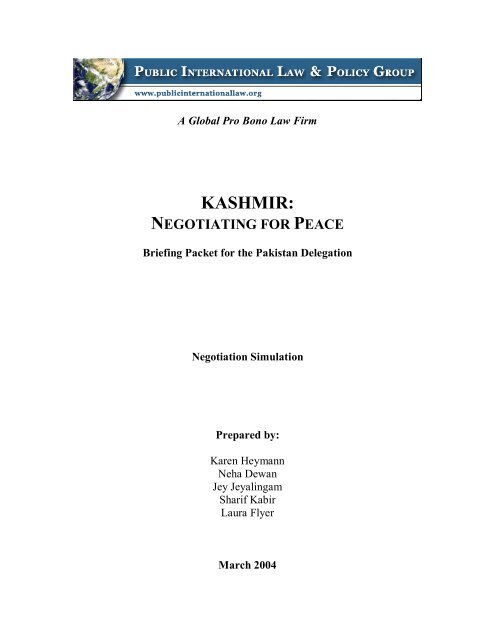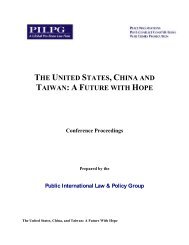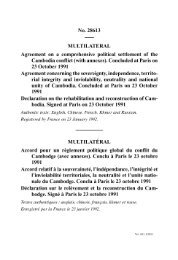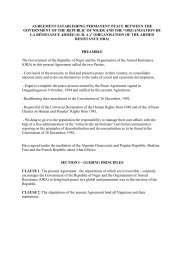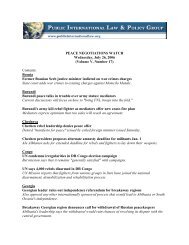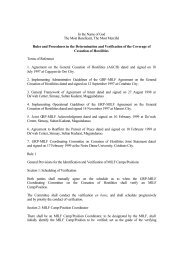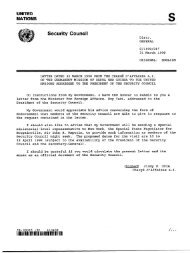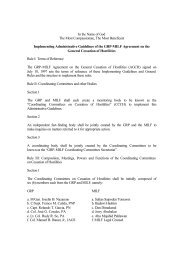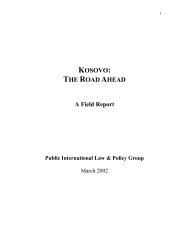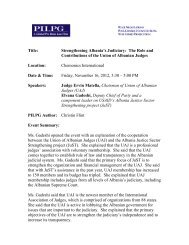Pakistan Delegation Negotiation Briefing Packet - PILPG
Pakistan Delegation Negotiation Briefing Packet - PILPG
Pakistan Delegation Negotiation Briefing Packet - PILPG
Create successful ePaper yourself
Turn your PDF publications into a flip-book with our unique Google optimized e-Paper software.
A Global Pro Bono Law Firm<br />
KASHMIR:<br />
NEGOTIATING FOR PEACE<br />
<strong>Briefing</strong> <strong>Packet</strong> for the <strong>Pakistan</strong> <strong>Delegation</strong><br />
<strong>Negotiation</strong> Simulation<br />
Prepared by:<br />
Karen Heymann<br />
Neha Dewan<br />
Jey Jeyalingam<br />
Sharif Kabir<br />
Laura Flyer<br />
March 2004
TABLE OF CONTENTS<br />
Introduction<br />
Brief Chronology of the Crisis in Kashmir<br />
Overview of the Central Negotiating Issues<br />
Introduction to the Parties and their Positions<br />
India<br />
<strong>Pakistan</strong><br />
Jammu & Kashmir Liberation Front<br />
All Parties Hurriyat Conference<br />
<strong>Delegation</strong> Instructions<br />
Annex A: Agenda<br />
Annex B: Necessary Texts<br />
Annex C: Maps<br />
Annex D: Proposed Final Status Solutions: A BBC Special Report<br />
2
Introduction<br />
The purpose of this negotiation simulation is to surface key issues and<br />
potential solutions to the points of impasse which will likely arise during<br />
future negotiations on Kashmir.<br />
The negotiation simulation has been developed using the methodology<br />
employed by the US Department of State’s National Foreign Affairs<br />
Training Institute which runs similar negotiations to train US diplomats prior<br />
to negotiations.<br />
This simulation exercise is not intended to be a comprehensive review of all<br />
the issues involved, nor is it intended to endorse one view over the other.<br />
The participants in the simulation naturally will have varying levels of<br />
substantive or area expertise, as well as professional commitment to the<br />
issue. Participants are therefore encouraged to draw upon their individual<br />
experiences as they deem appropriate.<br />
To provide the necessary information to conduct this simulation, this<br />
briefing packet contains a brief chronology of the history of the conflict, the<br />
principal interests of the parties and other relevant actors, a discussion of the<br />
primary issues which are likely to be discussed during the next round of<br />
negotiations, and negotiating instructions for the delegations. Each<br />
delegation is provided only their instructions. Four annexes containing<br />
supplementary information are located at the end of the instructions.<br />
Particularly, the BBC recently provided an overview of seven possible<br />
scenarios for a solution to the problem of final status of the Kashmir<br />
territory. These scenarios may provide a starting point for final status<br />
discussions between the parties. These seven scenarios and corresponding<br />
maps are provided at Annex D.<br />
The negotiation simulation has been prepared by the Public International<br />
Law & Policy Group in cooperation with American University and is made<br />
possible by a grant from the Carnegie Corporation of New York. The Public<br />
International Law & Policy Group (<strong>PILPG</strong>) is a 501(c)3 non-profit<br />
organization, which operates as a global pro bono law firm providing free<br />
legal assistance to developing states and states in transition involved in<br />
conflicts. To facilitate the utilization of this legal assistance, <strong>PILPG</strong> also<br />
provides policy formulation advice and training on matters related to conflict<br />
3
esolution. To date, <strong>PILPG</strong> has advised over a dozen countries on the legal<br />
aspects of peace negotiations and constitution drafting, and over fifteen<br />
countries in Europe, Asia and Africa concerning the protection of human<br />
rights, self-determination, and the prosecution of war crimes.<br />
4
Brief Chronology of the Crisis in Kashmir<br />
The purpose of this chronology is to provide only a brief overview of the<br />
situation in Kashmir for those individuals that may not be familiar with the<br />
chronological history. It is not designed to be a comprehensive history of<br />
Kashmir.<br />
In the wake of the Second World War, the British relinquished colonial rule<br />
of the territory known as India and oversaw the creation of two separate<br />
independent states, India and <strong>Pakistan</strong>. India, under the leadership of<br />
Mahatma Gandhi and Prime Minister Jawaharlal Nehru, was to be a secular,<br />
federated state, offering political representation to the numerous religious<br />
and ethnic communities of India through local councils. The maharajahs of<br />
the princely states that were not specifically allocated to either <strong>Pakistan</strong> or<br />
India were given the choice of independence or accession to <strong>Pakistan</strong> or<br />
India.<br />
The First Indo-<strong>Pakistan</strong>i War, which began in late 1947, was the beginning<br />
of the conflict as it persists today. The Hindu Maharaja of Jammu and<br />
Kashmir did not immediately make a choice between independence and<br />
accession. By October of 1947, armed Pashtun tribesman moved across the<br />
borders into Kashmir. In need of aid, the Maharaja turned to India for<br />
military support. India agreed to provide troops on the condition that<br />
Kashmir would accede to India.<br />
The Maharaja of Kashmir turned over administrative powers to India in an<br />
accession document. It was agreed to by both India and Kashmir, however,<br />
that the accession would be temporary, and that at the close of hostilities, a<br />
referendum would decide the issue of accession. <strong>Pakistan</strong>i military regulars<br />
joined the war in May 1948 to protect <strong>Pakistan</strong>'s border. By January of 1949<br />
hostilities came to a close under a UN fostered ceasefire.<br />
The ceasefire agreement of January 1, 1949 provided that the current<br />
territorial positions of military control were to form the status quo until the<br />
referendum was held. The <strong>Pakistan</strong>-controlled territory to the west of the<br />
ceasefire line consists of a small semi-autonomous region, referred to Azad<br />
Kashmir (meaning “free Kashmir”) and a larger area comprised of the<br />
former kingdoms of Hunza and Nagar, referred to as the northern areas.<br />
The ceasefire reaffirmed the notion that a referendum should ultimately<br />
determine the status of Kashmir and approved the existing ceasefire line<br />
until such referendum should occur. Five years passed without a<br />
5
eferendum, and in 1954 the Constituent Assembly of Jammu and Kashmir<br />
ratified the accession to India. The legal authority of the Constituent<br />
Assembly and the ratification of the accession remained questionable.<br />
In August of 1965 conflict resumed in Kashmir. The second Indo-Pak war<br />
was fought in three weeks and again ended in a UN-facilitated ceasefire. In<br />
signing the Tashkent Agreement, both parties agreed to return to the status<br />
quo ceasefire line negotiated previously, and pledged to refrain from the use<br />
of force to resolve the dispute.<br />
The resolution of the 1971 war, which was not directly related to the<br />
Kashmir question, produced an accord that nevertheless addressed the issue.<br />
The Simla Accord re-emphasized the need for peaceful means of dispute<br />
resolution, and it stressed the use of bilateral dialogue and working groups<br />
for all future conflicts between the two states. Furthermore, the two<br />
countries agreed that the current Kashmir ceasefire line, which was renamed<br />
the Line of Control, would be respected by both sides "without prejudice to<br />
the recognised positions of either side."<br />
In 1974 the Kashmir state government reached an accord with the Indian<br />
Government, which affirmed its status as "a constituent unit of the union of<br />
India." <strong>Pakistan</strong> rejected the accord.<br />
After a decade of relative quiet, the militant movement in the Kashmir<br />
Valley began in 1987 as many questioned the validity of the recent assembly<br />
elections. With the end of the war with the Soviets in Afghanistan in 1989<br />
many of the Mujahideen came to <strong>Pakistan</strong>, bringing Islamist extremism to<br />
what had begun as a secular/nationalist militant movement.<br />
India detonated its first nuclear device in 1974 in Rajistan, near the <strong>Pakistan</strong>i<br />
border, thus establishing India as a nuclear power and adding a new,<br />
dangerous dimension to Indo-Pak relations. <strong>Pakistan</strong> also began testing its<br />
first surface to surface missiles, and by 1992 <strong>Pakistan</strong> claimed to have<br />
nuclear capabilities. Since then, India-<strong>Pakistan</strong> relations have included the<br />
possibility of nuclear escalation. In 1998, India detonated five more nuclear<br />
devices in Rajistan. <strong>Pakistan</strong> responded by itself detonating six devices in<br />
Baluchistan. <strong>Pakistan</strong> also test launched its first medium-range ballistic<br />
missile (900-mile range). <strong>Pakistan</strong> has made clear that it will employ a<br />
necessary first-use approach to the use of nuclear weapons. The United<br />
Nations expressed concern with the parties’ strategies on nuclear warfare,<br />
and the G-8 threatened numerous economic sanctions.<br />
6
The year of 1997 marked fifty years of independence for the two states. It<br />
also marked fifty years of conflict over Kashmir’s status. With that in mind,<br />
India and <strong>Pakistan</strong> redoubled diplomatic efforts in search of a solution to the<br />
dispute over Kashmir. Though the talks began with a positive outlook, they<br />
quickly halted, with the parties agreeing to continue the dialogue at a later<br />
time.<br />
Dialogue between India and <strong>Pakistan</strong> resumed in 1999. Indian Prime<br />
Minister Atal Vajpayee and <strong>Pakistan</strong>i Prime Minister Nawaz Sharif signed<br />
the Lahore Accord in February. The Accord again reaffirmed the parties'<br />
desires to settle the dispute over Jammu and Kashmir.<br />
However, the Accord held only until May of the same year. An Indian<br />
patrol spotted intruders across the Line of Control. The Indian military<br />
began air raids in the region, and in response <strong>Pakistan</strong> began shelling the<br />
Kargil region. International pressure brought an end to the struggle but not<br />
before displacing some 30,000 people on both sides of the Line of Control.<br />
Shortly after Kargil, a coup led by General Pervez Musharraf toppled the<br />
Sharif government. Although the <strong>Pakistan</strong>i Supreme Court granted<br />
legitimacy to Musharraf’s rule for three years, the international community<br />
expressed their disapproval of Musharraf's ascension until 2001.<br />
The year 2001 proved tumultuous in the world and in India-<strong>Pakistan</strong><br />
relations. In May, India ended a ceasefire against Kashmiri militants, while<br />
also asking for dialogue. Musharraf and Vajpayee met at Agra in July for a<br />
three-day summit, but failed to produce any agreement on Kashmir. The<br />
events of September 11, 2001 improved the bargaining power of <strong>Pakistan</strong> as<br />
it became a key ally of the United States in the subsequent War on Terror.<br />
In October and December, tensions increased as twin bombings of the<br />
Kashmiri Assembly and the Indian Parliament killed fifty people. Troops<br />
were amassed by both sides along the Line of Control, leading to minor<br />
skirmishes.<br />
In January 2002, Musharraf called for talks between the states. Dialogue<br />
was not, however, forthcoming. Rather, 2002 was marked by tensions on<br />
both sides of the Line of Control. Nuclear tensions continued between New<br />
Delhi and Islamabad and then increased in the early months of the year,<br />
which was reinforced by an active exchange of accusations in the media.<br />
The October election in Indian-held Kashmir further strained relations. It is<br />
argued that over 500 deaths resulted from clashes between Kashmiri<br />
protestors to the elections and Indian security forces.<br />
7
A heightened level of tension between India and <strong>Pakistan</strong> continued through<br />
the early months of 2003. The year began with each nation expelling the<br />
other's diplomats. In Srinigar on April 18, 2003, however, Prime Minister<br />
Vajpayee made his own overture to Musharraf. By May, India agreed to<br />
reestablish diplomatic ties with Islamabad, and by October, some bus and<br />
rail ties were resumed between the two states. India also made an important<br />
concession, by agreeing to open a line of dialogue with the All Parties<br />
Hurriyat Conference. Talks with Kashmiri groups have previously been<br />
denied outright. On November 26 a ceasefire offered by <strong>Pakistan</strong> to India<br />
went into effect in Kashmiri territory.<br />
The year 2004 began with renewed dialogue between Musharraf and<br />
Vajpayee at a summit meeting of South Asian nations. Recent strikes at<br />
Musharraf by militant groups may be the catalyst for an aggressive approach<br />
by <strong>Pakistan</strong>is to curb the activities of militants, generating momentum to the<br />
long-delayed status talks with India. The optimism has in part been fueled<br />
by the fact that the January 5 Islamabad declaration identified the<br />
willingness of the parties to negotiate a peaceful settlement of all bilateral<br />
issues.<br />
As the brief historical overview indicates, the Kashmir negotiations will<br />
involve discussions of final status, demilitarization and decommissioning,<br />
and humanitarian issues. The parties will unlikely be able to discuss final<br />
status without simultaneous talks regarding demilitarization. For example,<br />
the UN Security Council resolution supported a plebiscite but only after a<br />
total troop withdrawal. <strong>Negotiation</strong>s of humanitarian issues are necessary<br />
because all sides of the dispute cite humanitarian concerns as a basis for<br />
their positions on final status and decommissioning and demilitarization.<br />
Thus, it is likely that negotiations of all three issues will be ongoing<br />
throughout the negotiation simulation.<br />
8
Overview of the Central Negotiating Issues<br />
The discussion of final status, demilitarization, and humanitarian issues are<br />
not likely to be initially discussed during the negotiations. As witnessed in<br />
prior negotiations, the parties will first discuss issues such as re-opening bus<br />
routes and other confidence-building measures. For the purpose of this<br />
simulation, discussions will revolve around the three selected issues because<br />
these have been the long-standing points of dissention between the parties.<br />
The participants should not view the selection of these issues for discussion<br />
as ignoring other important negotiating issues. As such, the participants can<br />
introduce additional points of contention as they deem appropriate.<br />
Final Status:<br />
From the beginning of the Kashmir conflict, the central underlying issue has<br />
been Kashmir’s final status. Although the original issue existed only<br />
between <strong>Pakistan</strong> and India, the conflict has unfolded in such a way that<br />
many Kashmiris now seek independence for Kashmir instead of accession to<br />
either <strong>Pakistan</strong> or India. Each party relies on historical, social and legal<br />
foundations to support their arguments. India bases its belief that all of<br />
Kashmir is rightfully a part of India on Maharajah Singh’s initial accession<br />
agreement. <strong>Pakistan</strong> argues, on the other hand, that the accession was<br />
subject to later popular approval by the people of Kashmir. The separatist<br />
Kashmiris argue that the state would have remained independent without the<br />
interference of <strong>Pakistan</strong> and India.<br />
Kashmir is now divided, which makes the conflict more difficult to resolve.<br />
Azad Kashmir has been a part of <strong>Pakistan</strong> for over fifty years, but India<br />
maintains that all of Kashmir must be united within the India. Conversely,<br />
<strong>Pakistan</strong> insists that Azad Kashmir is now part of <strong>Pakistan</strong>. It has been<br />
suggested that the current line of control, which separates Azad Kashmir<br />
from the rest of Kashmir, should serve as the permanent boundary between<br />
the two countries. This does not consider, however, the separatist Kashmir<br />
groups’ struggle for Kashmiri independence from both <strong>Pakistan</strong> and India.<br />
Additionally, both <strong>Pakistan</strong> and the Kashmiri separatists insist that the future<br />
of Kashmir must be decided by a free and fair plebiscite as provided by the<br />
U.N. Security Council resolution. India claims first that there is no need for<br />
a plebiscite because the continued participation of Kashmiris in Indian<br />
9
elections has confirmed that the Kashmiris wish to remain a part of India.<br />
India additionally cites the requirement, contained in Security Council<br />
Resolution 726, of a total withdrawal of troops from Kashmir prior to any<br />
plebiscite.<br />
Withdrawal and Demilitarization of Indian, <strong>Pakistan</strong>i, and Paramilitary<br />
Groups Acting in Kashmir<br />
India and <strong>Pakistan</strong> seem to be at a standstill regarding a withdrawal of troops<br />
from Kashmir. Although <strong>Pakistan</strong> previously denied any involvement in the<br />
pro-<strong>Pakistan</strong> accession groups acting within Kashmir, President Musharraf<br />
has recently taken responsibility for such activities occurring within the<br />
Azad region of Kashmir. <strong>Pakistan</strong> does not yet recognize any involvement<br />
or support for those groups acting within Indian-held Kashmir. Conversely,<br />
India insists that there will continue to be a need for the presence of Indian<br />
Security Forces within Kashmir so long as there continues to be paramilitary<br />
activity, which they assert is supported and funded by the <strong>Pakistan</strong><br />
government. Moreover, the paramilitary groups acting within Kashmir cite<br />
alleged human rights abuses by the Indian Security Forces as part of the<br />
need for their continued paramilitary activities.<br />
Humanitarian Issues:<br />
The human rights abuses suffered by those living in Kashmir are widespread<br />
and well documented. Between 1997 and 1999, militant forces from<br />
<strong>Pakistan</strong> killed more than 300 civilians in Kashmir. In response, Indian<br />
security forces retaliated against those they believed to be guilty for such<br />
crimes. Many sources report the use of rape, torture, extrajudicial<br />
executions, and disappearances as examples of such abuses. Although much<br />
of the extreme violence has diminished, detentions for extortion and attacks<br />
on the press by Indian countermilitant militias are reported to still exist.<br />
Each side, however, claims that it is not at fault. For instance, commentators<br />
claim that Indian forces justify the torture of <strong>Pakistan</strong>i militant forces by<br />
saying it was the only way to get information from them.<br />
Prosecutions rarely occur for these human rights abuses; the Indian<br />
government exacted some disciplinary measures, but as of yet there have<br />
been no criminal prosecutions. Parties will need to discuss the mechanisms<br />
for stopping the current violations as well as the possible need for a truth<br />
commission or tribunal to address the past wrongs against Kashmir.<br />
10
Introduction to the Participants and their Positions<br />
This section introduces the participants and their positions. Each<br />
participant’s position on various matters involving Kashmir are presented in<br />
order to provide insight into their negotiating interests. The parties involved<br />
in this negotiation simulation are India, <strong>Pakistan</strong>, the Jammu & Kashmir<br />
Liberation Front, and the All Parties Hurriyat Conference.<br />
India:<br />
India is a twenty-nine state constitutional federated republic led by President<br />
Abdul Kalam and Prime Minister Atal Behari Vajpayee. India's longstanding<br />
position on the Kashmir dispute is that the state of Jammu and<br />
Kashmir is a part of the Indian Union. Thus, India asserts that the only issue<br />
between India and <strong>Pakistan</strong> regarding Kashmir is <strong>Pakistan</strong>'s necessity to<br />
desist in its occupation of Azad Kashmir and the Northern Areas. India sees<br />
all other issues with regard to Kashmir are purely domestic.<br />
<strong>Pakistan</strong>:<br />
Nominally <strong>Pakistan</strong> exists as a federated parliamentary democracy. The role<br />
of the military since the coup of 1999, however, cannot be underestimated.<br />
Prime Minister Zafarullah Jamali is the head of state and chief executive,<br />
and Pervez Musharraf is President and Chief of Army Staff. <strong>Pakistan</strong> asserts<br />
that since 1947 Jammu and Kashmir has remained disputed territory because<br />
Kashmir’s accession to India was provisional. <strong>Pakistan</strong> bases this position<br />
on the Resolution adopted by the United Nations Commission for India and<br />
<strong>Pakistan</strong> on 13 August 1948. <strong>Pakistan</strong> holds that all future talks should be<br />
based on the Kashmiri people's right to self-determination as established by<br />
an internationally supervised plebiscite offering accession to either India or<br />
<strong>Pakistan</strong>. <strong>Pakistan</strong> does not support independence as an option for Kashmir.<br />
Though <strong>Pakistan</strong> also feels that future talks should be dictated by the Simla<br />
Agreement and any UN resolutions, <strong>Pakistan</strong> does not rule out third party<br />
mediation or good offices.<br />
Jammu Kashmir Liberation Front (JKLF):<br />
Founded in 1977, this secular movement has the primary objective of<br />
independence for Kashmir. They will not accept any solution that involves a<br />
constitutional status for Kashmir within India or <strong>Pakistan</strong>. Additionally,<br />
11
they do not accept the present status of the borders of Kashmir. The group<br />
has, however, diminished in importance over the years as the independent<br />
movement increasingly took on a religious character. The group has now<br />
splintered into two groups that both share the original name. One group has<br />
renounced the use of violence while the other has not. The violent faction<br />
was not invited to the negotiation simulation.<br />
All Parties Hurriyat Conference:<br />
Founded in 1993 the group is a coalition of 24 political, religious and social<br />
organizations. It seeks non-violent means to end the conflict and its goal is<br />
to gain independence for Kashmir. The main role of the group has been to<br />
sway public opinion against security forces and to further a negative image<br />
of counter-insurgency in Kashmir. Offering to participate in negotiations in<br />
2000, the group agreed to separate bilateral talks with India and <strong>Pakistan</strong>,<br />
rather than requiring multilateral talks with all groups.<br />
12
NEGOTIATION INSTRUCTIONS: PAKISTAN<br />
<strong>Pakistan</strong>’s Guiding Principles for <strong>Negotiation</strong>: The initial accession of<br />
Kashmir to India was illegal because India never allowed for the promised<br />
plebiscite. Kashmir is a Muslim state that should be part of <strong>Pakistan</strong>.<br />
<strong>Pakistan</strong> does not directly acknowledge responsibility for paramilitary<br />
actions in Kashmir, but it does support the right of the Kashmir people to<br />
revolt against India both because of India’s illegal seizure of Kashmir and<br />
its continued violation of Kashmiri human rights.<br />
The origins of the Kashmiri dispute lie in the many machinations during<br />
decolonization of British India. As the British withdrew, the subcontinent<br />
was partitioned into the religiously and culturally distinct states of India and<br />
<strong>Pakistan</strong> along the Radcliffe boundary. The princely states, however, in<br />
recognition of their special relationship with the British colonial<br />
government, were not in all instances partitioned with regard to their<br />
religious composition. Those states that were territorially contiguous to<br />
solely India or <strong>Pakistan</strong> acceded to those respective states; those that<br />
bordered on both, were given a choice, irrespective of the predominant<br />
religion in the province. The Dogra Kingdom of Jammu and Kashmir,<br />
positioned between the two states, was allowed to choose to which state it<br />
would accede. Though at the time of partition, the population of Jammu<br />
and Kashmir was predominantly Sunni Muslim (78%) and should therefore<br />
have rightfully joined the Muslim state of <strong>Pakistan</strong>, Maharaja Hari Singh of<br />
Jammu and Kashmir was Hindu and sympathetic to the Indian Hindu<br />
majority.<br />
While the Maharaja delayed his decision, he tightened his ties with India,<br />
and began a systematic extermination of Muslims within Jammu and<br />
Ladakh. Resistance formed, and armed Pashtun tribesman entered the<br />
Valley of Kashmir from the Poonch region of the state. <strong>Pakistan</strong>, whose<br />
military was still in a phase of transition to independent command, was in no<br />
position to either aid in or halt the incursion. To suppress the growing<br />
uprising, the Maharaja turned to India for aid, and under duress, India forced<br />
him to accede Jammu and Kashmir to the Indian Union in a quid pro quo<br />
return for military assistance.<br />
Though ostensibly an official Document of Accession was signed, Lord<br />
Mountbatten, the last Viceroy of the Dominion of India, realized this<br />
document did not have the necessary legitimacy to conclude the accession.<br />
13
He thus suggested, and Prime Minister Jawaharlal Nehru agreed, that<br />
administrative control of Kashmir would endure only for the duration of the<br />
conflict, and that final status would be determined by internal referendum<br />
after the conflict ceased. India made this concession to legitimize its use of<br />
duress and under the assumption that the recently appointed prime minister,<br />
Sheik Abdullah, as a member of the Indian National Conference would<br />
secure the results of the referendum. At the close of combat the UN<br />
facilitated ceasefire arrangement reaffirmed the previous agreement to allow<br />
a plebiscite to determine final status of the Kingdom of Kashmir.<br />
However, in the years that followed the war, India refused to obey the<br />
demilitarization provision of the U.N. resolutions. India also would not<br />
agree to the appointment of a neutral interim government to supervise the<br />
plebiscite, and thus the plebiscite did not materialize. As time proceeded and<br />
the relationship between Sheik Abdullah and Prime Minister Jawaharlal<br />
Nehru deteriorated, the Indian government became increasingly reticent in<br />
regard to the issue of referendum. India no longer felt that success was<br />
guaranteed.<br />
The reaffirmation of accession by the Indian controlled constituent<br />
assembly, on February 6, 1954, again ignored the provisions in Security<br />
Council resolution 91. Resolution 91 states that no acts of the constituent<br />
assembly shall prejudice the future status of Jammu and Kashmir as decided<br />
by the will of the people though the plebiscite. Moreover, that mere fact that<br />
a small number of Kashmiris participated in the legislative process no more<br />
legitimizes the process than the small number of Indians participating in the<br />
colonial legislature represented their acquiescence to colonial rule.<br />
Though India proffers the notion that the 1972 Simla Accord superceded the<br />
United Nations Resolutions, this argument lacks any legal merit. The Indian<br />
assertion that the commitment to bilateral negotiation precludes the option of<br />
a plebiscite belies the Simla Accord's further commitment and India's own<br />
obligation to the U.N. charter. U.N.G.A. resolution 1172 addresses the<br />
obligation of the parties to settle this conflict peacefully within the<br />
framework of the U.N. Charter.<br />
In the late 1980s unrest grew as India continued to suffocate nascent<br />
resistance movement and buttress its minority control with tainted elections.<br />
The increasing crackdowns and arrests of opposition party members fueled<br />
the disaffection of the youth, and forced many into militant groups. This<br />
also led to the creation of the umbrella party, All Parties Hurriyat<br />
14
Conference. It was in this context that Kashmiri insurgency began. India<br />
itself has fostered acts of terror within Kashmir in effort to sway<br />
international opinion. While the acts of Kashmiris fighting the oppression of<br />
their Indian occupiers can hardly be considered terrorism, state sponsored<br />
acts, the type India perpetrates, most certainly are. The struggle in Kashmir<br />
is between the Kashmiri people and India.<br />
It is the <strong>Pakistan</strong>i position that Kashmiris should have the right to selfdetermination<br />
as within UN Resolutions 47, 51, 80, 91 and 122. Further<br />
<strong>Pakistan</strong> believes it is its duty to protect the right of Kashmiri citizens<br />
against human rights abuses at the hands of the 700,000 strong Indian<br />
occupying force. <strong>Pakistan</strong> has called for, and India has rejected, open<br />
dialogue with <strong>Pakistan</strong>, a reciprocal ceasefire along the Line of Control in<br />
Kashmir, a ceasefire within Indian occupied Kashmir, enhanced monitoring<br />
of the Line of Control on both sides in Kashmir, and maintenance of an arms<br />
balance both in conventional and non-conventional sectors between India<br />
and <strong>Pakistan</strong>. It is <strong>Pakistan</strong>'s ultimate ambition to see the carrying out of the<br />
Security Councils resolutions, and for the long overdue will of the Kashmiri<br />
people to be represented by plebiscite. All other positions are subordinate to<br />
this goal and are predicated upon this eventuality.<br />
Reconciliation, like demilitarization, must be phased. <strong>Pakistan</strong> has<br />
consistently made reconciliation gestures to India, yet has met with little<br />
success from an obdurate Indian government. In as much as the dispute over<br />
Kashmir has endured for more than fifty years with numerous stops and<br />
starts, any new round of talks will be approached cautiously.<br />
Notwithstanding that fact, diplomatic ties between India and <strong>Pakistan</strong> were<br />
recently normalized again.<br />
January 2004 has again brought guarded optimism with renewed talks at the<br />
highest level. <strong>Pakistan</strong>, and President Musharraf are resolved to create an<br />
enduring solution to the Kashmiri issue. In so doing, it is <strong>Pakistan</strong>'s hope<br />
that it should be able to foster a solid and lasting relationship, both<br />
diplomatically and economically, with India. Reconciliation will of course<br />
be based on the satisfactory resolution of aforementioned issues. There<br />
cannot be a true reconciliation between India and <strong>Pakistan</strong> without adequate<br />
solutions for these important issues.<br />
15
Issues<br />
Final Status<br />
It is <strong>Pakistan</strong>'s position that in following the intent and logic of partition,<br />
Kashmir was to have become a part of the Islamic Republic of <strong>Pakistan</strong>, and<br />
should today by that logic do the same. <strong>Pakistan</strong> is confident that the will of<br />
the Kashmiri people will be adequately represented in a fair and neutral<br />
plebiscite as per the agreement reached in the UN resolutions following the<br />
1947 war. Further, <strong>Pakistan</strong> is confident the results of such a plebiscite will<br />
vindicate the position <strong>Pakistan</strong> has held for a half century: that it is the will<br />
of the majority of Kashmiri's to join their Muslim brethren as an integral part<br />
of the Republic of <strong>Pakistan</strong>.<br />
Officially, <strong>Pakistan</strong> only supports Kashmiri self-determination insofar as that<br />
determination is to accede to <strong>Pakistan</strong> or India. Kashmiri accession to India,<br />
though not anticipated, would be likely be accepted both out of political<br />
necessity and international obligation if it were determined to be the will of<br />
the people under fair conditions. This is the traditional and long-held<br />
position, though whispers of the third option (independence) are now heard<br />
within the government. Those in support of a third option are still a silent<br />
and small minority; the majority consider the option untenable at best, and<br />
possibly disastrous.<br />
Objectives: <strong>Pakistan</strong>’s objective is to ensure the holding of a free, fair and<br />
internationally supervised plebiscite as envisioned in the United Nations<br />
Security Council Resolutions 47, 51, 80, 91 and 122 (see Annex B). The<br />
options for referendum should include the choices of accession to <strong>Pakistan</strong><br />
or to India as originally conceived by the United Nations. The ultimate<br />
objective of <strong>Pakistan</strong> is the fostering of self-determination. It is the belief of<br />
<strong>Pakistan</strong> that the will of the Kashmiri people is to be united with their<br />
Muslim brethren in <strong>Pakistan</strong>. <strong>Pakistan</strong> wishes to end further subjugation of<br />
Kashmiri Muslims at the hands of the Indian government <strong>Pakistan</strong> seeks<br />
productive dialogue in any form (i.e. bilateral, trilateral, etc.) on the issue of<br />
Kashmir. The All Parties Hurriyat Conference should be included in any<br />
talks insofar as the APHC is the representative voice of the Kashmiri people.<br />
16
Acceptable Minimum: The plebiscite need not be – and it is recognized that<br />
it probably could not be – held as a province-wide referendum; but rather a<br />
regional or districted referendum would likely be acceptable.<br />
Withdrawal and Demilitarization of Indian, <strong>Pakistan</strong>i, and Paramilitary<br />
Groups Acting in Kashmir<br />
<strong>Pakistan</strong> is increasingly concerned with the atrocities perpetrated by the<br />
Indian Army and by the Indian supported border security forces against<br />
Kashmiri Muslims. <strong>Pakistan</strong> seeks a return to normalcy for Kashmiri<br />
citizens and is of the mind that the most important means of bringing this<br />
about is a withdrawal of the Indian military presence. The troop to civilian<br />
ratio in occupied Kashmir (approx. 1:13) is the largest in the world. India<br />
currently maintains 600,000-700,000 troops – including regular army,<br />
paramilitary troops, border security force and police – in occupied Kashmir.<br />
Additionally, India employs thousands of “counter-militants" as a means of<br />
violently putting down indigenous uprisings.<br />
Insofar as militarization of Jammu and Kashmir has been a half century<br />
affair, <strong>Pakistan</strong> realizes that demilitarization will require time. In order to<br />
begin meaningful dialogue, however, <strong>Pakistan</strong> believes that it is necessary<br />
for both India and <strong>Pakistan</strong> to demobilize the Line of Control, and for India<br />
to demilitarize Jammu and Kashmir. Accordingly UNMOGIP would need<br />
to be expanded both in size and mandate to fill the vacuum.<br />
The solution lies in the international community's willingness to implement<br />
the binding Security Council resolutions and to end Indian state terrorism in<br />
occupied Kashmir. The half-century-old resolutions call demilitarization of<br />
Kashmir, followed immediately by a plebiscite under UN supervision to<br />
determine the future status of Kashmir. India's reticence to engage in serious<br />
talks makes the participation of the international community a necessity.<br />
Such an intervention is also urgently required to stop the ever-growing<br />
Indian brutalities against the innocent Muslim people of Kashmir, who have<br />
been long denied their just right to self-determination.<br />
Objectives: <strong>Pakistan</strong> proposes full, phased withdrawal of Indian forces from<br />
the LOC and from the territory of Jammu and Kashmir, as well as the<br />
replacement of an Indian presence with United Nations peace keepers in<br />
both a political and military observation capacity. <strong>Pakistan</strong> would like for<br />
the United Nations to take actions against India per its duty to maintain<br />
17
international peace and security. India should be sanctioned for its<br />
numerous threats to international security both through conventional and<br />
nuclear arms. <strong>Pakistan</strong> also mandates Indian acceptance of the offered "no<br />
threat of force" pact.<br />
Acceptable Minimum: <strong>Pakistan</strong> wants a partial, yet substantial<br />
demilitarization, as a gesture of good faith and as an initial confidence<br />
building measure. Also, they would like a replacement by U.N. forces or<br />
those of another neutral party.<br />
Humanitarian Issues<br />
<strong>Pakistan</strong>'s remains enormously concerned with the inhumane treatment of<br />
Kashmiri Muslims by Indian forces, as well as the pervasive corruption, both<br />
in Kashmir and New Delhi, that is the cause. Since the start of popular<br />
uprising, thousands of innocent Kashmir people have been killed by the<br />
Indian occupation forces. There are various estimates of these killings.<br />
According to government of India estimates, the number of persons killed in<br />
occupied Kashmir between 1989 and 1996 was 15,000. Other Indian leaders<br />
have stated a much higher figure, with the former Indian minister stating<br />
numbers between 40,000 and 50,000 killings. The international press<br />
estimates the number to be around 20,000. Whatever the number, it is clear<br />
that Kashmir has seen a significant amount of atrocities. Despite repeated<br />
requests over the years by world human rights organizations such as<br />
the Amnesty International, the Indian government has not permitted them<br />
any access to occupied territories. In 1997, it refused the United Nations<br />
representatives permission to visit there.<br />
Objectives: <strong>Pakistan</strong> seeks an immediate cessation of human rights abuses<br />
within occupied Kashmir. <strong>Pakistan</strong> believes that the sole means by which to<br />
achieve an end to human rights abuses is the withdrawal of Indian forces<br />
from Kashmir.<br />
Acceptable Minimum: <strong>Pakistan</strong> would accept strict compliance with basic<br />
international human rights documents.<br />
18
Annex A: Agenda for <strong>Negotiation</strong>s<br />
9:00 am Coffee and doughnuts available for participants<br />
9:30 – 9:45 am Introduction and review of simulation schedule and<br />
procedures<br />
9:45 – 10:15 am Individual delegation meetings to review positions and<br />
determine representation for delegation sub-groups.<br />
• JK Liberation Front and APH Conference hold brief<br />
separate meeting prior to joining as a joint delegation<br />
10:15 – 10:45 am Session 1: Small bilateral meetings between the<br />
following groups to discuss Demilitarization and<br />
Humanitarian Issues:<br />
• <strong>Pakistan</strong> Team 1 and India Team 1<br />
• <strong>Pakistan</strong> Team 2 and JKLF/APHC joint Team 1<br />
• India Team 2 and JKLF/APHC joint Team 2<br />
• US where necessary<br />
10:45 – 11:00 am Coffee Break and Shuttle Diplomacy<br />
11:00 – 11:30 am Individual delegation meetings to review Session 1<br />
negotiations<br />
11:30 – 12:00 pm Session 2: Small bilateral meetings between the<br />
following groups to discuss Final Status issues:<br />
• India Team 1 and <strong>Pakistan</strong> Team 1<br />
• India Team 2 and JKLF/APHC joint Team 1<br />
• <strong>Pakistan</strong> Team and JKLF/APHC joint Team 2<br />
• US where necessary<br />
12:00 – 12:30 pm Individual delegation meetings to focus on substantive<br />
negotiating issues<br />
(Lunch will be provided during this meeting)<br />
12:30 – 1:00 pm Plenary Session<br />
1:00 – 1:20 pm Resume Small Group Meetings as determined by parties<br />
and mediators<br />
1:20 – 1:45 pm Final Plenary Session<br />
1:45 – 2:20 pm Review and Lessons Learned<br />
19
Annex B: Necessary Texts:<br />
India-<strong>Pakistan</strong> Peace Agreements:<br />
Tashkent Declaration:<br />
www.kashmir-information.com/LegalDocs/tashkent.html<br />
Simla Agreement:<br />
www.indianembassy.org/policy/Kashmir/shimla.htm<br />
Lahore Declaration:<br />
www.usip.org/library/pa/ip/ip_lahore19990221.htm<br />
United Nations Security Council Resolutions<br />
Resolution 47 (1948) on the India-<strong>Pakistan</strong> question adopted by the Security<br />
Council on 21 April, 1948. (Document No. S/726 dated 21 April 1948.)<br />
Resolution 51 (1948) on the India-<strong>Pakistan</strong> Question adopted by the<br />
Security Council on 3 June 1948 (Document No. S/819 dated 3 June, 1948.)<br />
Resolution 80 (1950) concerning the India-<strong>Pakistan</strong> Question adopted by the<br />
Security Council on 14 March, 1950. (Document no. S/1469, dated 14<br />
March, 1950)<br />
Resolution 91 (1951) concerning the India-<strong>Pakistan</strong> Question adopted by<br />
the Security Council on 30 March, 1951 (Document No. S/2017/Rev.I, dated<br />
30 March, 1951)<br />
Article 370 of the Indian Constitution<br />
http://www.kashmir-information.com/legaldocs/article370.html<br />
20
Annex C: Maps<br />
http://www.un.org/Depts/Cartographic/map/profile/kashmir.pdf<br />
21
Annex D: Proposed Scenarios for Resolution of Kashmir<br />
A BBC Special Report<br />
Scenario one: The status quo<br />
Kashmir has been a flashpoint between India and <strong>Pakistan</strong> for more than 50<br />
years. Currently a boundary - the Line of Control - divides the region in two,<br />
with one part administered by India and one by <strong>Pakistan</strong>. India would like to<br />
formalise this status quo and make it the accepted international boundary.<br />
But <strong>Pakistan</strong> and Kashmiri activists reject this plan because they both want<br />
greater control over the region.<br />
http://news.bbc.co.uk/1/shared/spl/hi/south_asia/03/kashmir_future/htm<br />
l/default.stm<br />
23
Scenario two: Kashmir joins <strong>Pakistan</strong><br />
<strong>Pakistan</strong> has consistently favoured this as the best solution to the dispute. In<br />
view of the state's majority Muslim population, it believes that it would vote<br />
to become part of <strong>Pakistan</strong>. However a single plebiscite held in a region<br />
which comprises peoples that are culturally, religiously and ethnically<br />
diverse, would create disaffected minorities. The Hindus of Jammu, and the<br />
Buddhists of Ladakh have never shown any desire to join <strong>Pakistan</strong> and<br />
would protest at the outcome.<br />
http://news.bbc.co.uk/1/shared/spl/hi/south_asia/03/kashmir_future/html/2.st<br />
m<br />
24
Scenario three: Kashmir joins India<br />
Such a solution would be unlikely to bring stability to the region as the<br />
Muslim inhabitants of <strong>Pakistan</strong>i-administered Jammu and Kashmir,<br />
including the Northern Areas, have never shown any desire to become part<br />
of India.<br />
http://news.bbc.co.uk/1/shared/spl/hi/south_asia/03/kashmir_future/html/3.st<br />
m<br />
25
Scenario four: Independent Kashmir<br />
The difficulty of adopting this as a potential solution is that it requires India<br />
and <strong>Pakistan</strong> to give up territory, which they are not willing to do. Any<br />
plebiscite or referendum likely to result in a majority vote for independence<br />
would therefore probably be opposed by both India and <strong>Pakistan</strong>. It would<br />
also be rejected by the inhabitants of the state who are content with their<br />
status as part of the countries to which they already owe allegiance.<br />
http://news.bbc.co.uk/1/shared/spl/hi/south_asia/03/kashmir_future/html/4.st<br />
m<br />
26
Scenario five: A smaller independent Kashmir<br />
An independent Kashmir could be created from the Kashmir Valley -<br />
currently under Indian administration - and the narrow strip of land which<br />
<strong>Pakistan</strong> calls Azad Jammu and Kashmir. This would leave the strategically<br />
important regions of the Northern Areas and Ladakh, bordering China, under<br />
the control of <strong>Pakistan</strong> and India respectively. However both India and<br />
<strong>Pakistan</strong> would be unlikely to enter into discussions which would have this<br />
scenario as a possible outcome.<br />
http://news.bbc.co.uk/1/shared/spl/hi/south_asia/03/kashmir_future/html/5.st<br />
m<br />
27
Scenario six: Independent Kashmir Valley<br />
An independent Kashmir Valley has been considered by some as the best<br />
solution because it would address the grievances of those who have been<br />
fighting against the Indian Government since the insurgency began in 1989.<br />
But critics say that, without external assistance, the region would not be<br />
economically viable.<br />
http://news.bbc.co.uk/1/shared/spl/hi/south_asia/03/kashmir_future/html/6.st<br />
m<br />
28
Scenario seven: The Chenab formula<br />
This plan, first suggested in the 1960s, would see Kashmir divided along the<br />
line of the River Chenab. This would give the vast majority of land to<br />
<strong>Pakistan</strong> and, as such, a clear victory in its longstanding dispute with India.<br />
The entire valley with its Muslim majority population would be brought<br />
within <strong>Pakistan</strong>'s borders, as well as the majority Muslim areas of Jammu.<br />
http://news.bbc.co.uk/1/shared/spl/hi/south_asia/03/kashmir_future/html/7.stm<br />
29


